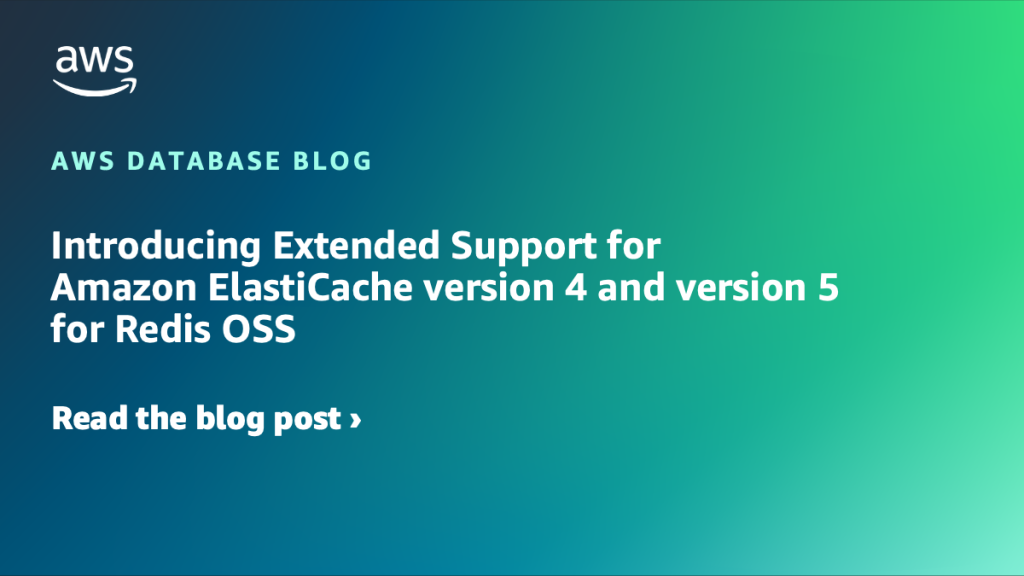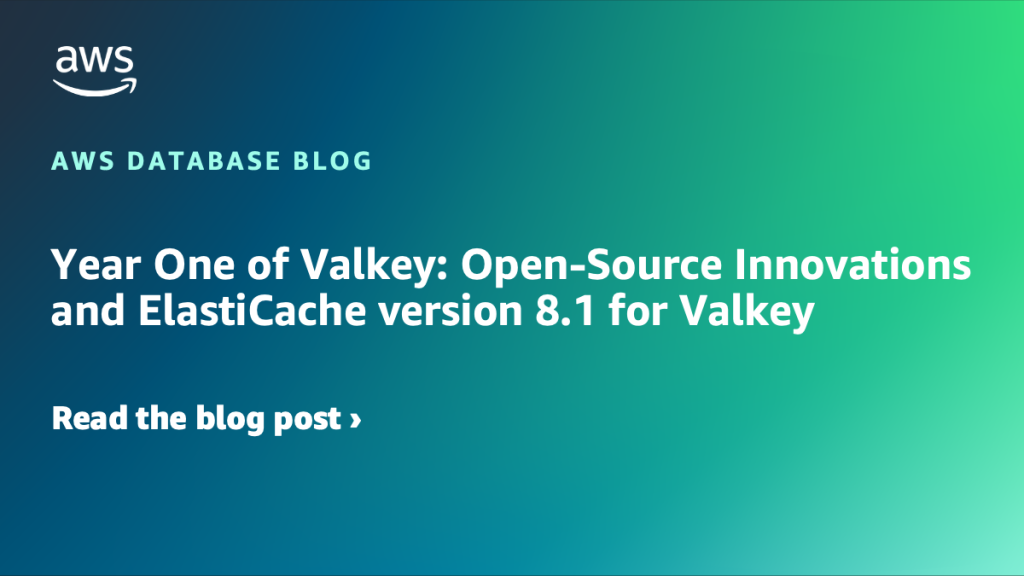AWS Database Blog
Category: Intermediate (200)
Introducing Extended Support for Amazon ElastiCache version 4 and version 5 for Redis OSS
Amazon ElastiCache now offers Extended Support so that you can upgrade to a new major version at a pace that meets your business requirements. Extended Support is a paid offering that provides critical security updates, bug fixes, and continued support for ElastiCache versions 4 and 5 for Redis OSS through January 31, 2029. Starting on February 1, 2026, ElastiCache Redis OSS v4 and v5 clusters that haven’t been upgraded will be automatically enrolled in Extended Support to provide continuous availability and security. In this post, we discuss what ElastiCache Extended Support entails, its key benefits, and the upgrade options available.
Year One of Valkey: Open-Source Innovations and ElastiCache version 8.1 for Valkey
In April 2024, AWS announced support for Valkey, a community-driven fork of Redis born out of a shared belief that critical infrastructure software should be vendor neutral and open source. In this post, we share how, just over a year in, we remain fully committed to the Valkey project and announce support for the latest version with Amazon ElastiCache version 8.1 for Valkey. We explore the benefits of Valkey through real-world examples the benefits of the latest innovations, including a new hash table with additional memory efficiencies, support for Bloom filters, observability enhancements, and new functionality.
Amazon Aurora DSQL for gaming use cases
In this post, we show you how Amazon Aurora DSQL powers modern gaming use cases from real-time multiplayer interactions to globally consistent leaderboards by delivering seamless scalability, strong consistency and built-in multi-region availability.
How Aqua Security automates fast clone orchestration on Amazon Aurora at scale
Aqua Security is a leading provider of cloud-based security solutions, trusted by global enterprises to secure their applications from development to production. In this post, we explore how Aqua Security automates the use of Amazon Aurora fast clones to support read-heavy operations at scale, simplify their data workflows, and maintain operational efficiency.
How to evaluate throughput utilization for Amazon DynamoDB tables in provisioned mode
In this post, we demonstrate how to evaluate throughput utilization for DynamoDB tables in provisioned mode. Understanding this metrics helps you determine whether switching to on-demand mode is the right choice. Moving to on-demand mode, where you pay-per-request for throughput, can optimize costs, eliminate capacity planning, minimize operational overhead, and enhance overall user experience for your applications.
SQL to NoSQL: Planning your application migration to Amazon DynamoDB
This is the first part of a series exploring how to effectively migrate from SQL to DynamoDB. We will examine how to analyze existing database structures and access patterns to prepare for migration, focusing on schema analysis, query patterns, and usage metrics that inform DynamoDB data model design.
Better together: Amazon RDS for SQL Server and Amazon SageMaker Lakehouse, a generative AI data integration use case
Generative AI solutions are transforming how businesses operate worldwide. It has now become paramount for businesses to integrate generative AI capabilities into their customer-facing services and applications. The challenge they often face is the need to use massive amounts of relational data hosted on SQL Server databases to contextualize these new generative AI solutions. In this post, we demonstrate how you can address this challenge by combining Amazon RDS for SQL Server and Amazon SageMaker Lakehouse.
Announcing Valkey GLIDE 2.0 with support for Go, OpenTelemetry, and batching
AWS recently announced, in partnership with Google Cloud and the Valkey community, the general availability of Valkey General Language Independent Driver for the Enterprise (GLIDE) 2.0, the latest release. Valkey GLIDE is multi-language client library designed for reliability and performance. In this post, we discuss what Valkey GLIDE is and its key benefits, and then dive into its new enhancements.
Supercharging AWS database development with AWS MCP servers
Amazon Aurora, Amazon DynamoDB, and Amazon ElastiCache are popular choices for developers powering critical workloads, including global commerce platforms, financial systems, and real-time analytics applications. To enhance productivity, developers are supplementing everyday tasks with AI-assisted tools that understand context, suggest improvements, and help reason through system configurations. Model Context Protocol (MCP) is at the helm of this revolution, rapidly transforming how developers integrate AI assistants into their development pipelines. In this post, we explore the core concepts behind MCP and demonstrate how new AWS MCP servers can accelerate your database development through natural language prompts.
Leveling up Amazon RDS with AWS Graviton4: Benchmarks
In November 2024, AWS introduced the latest evolution of its custom-designed ARM-based processors with Graviton4, delivering significant performance and efficiency improvements for Amazon RDS for PostgreSQL, MySQL, and MariaDB and Amazon Aurora. In this post, we focus on Amazon RDS for PostgreSQL and compare the performance of the new Graviton4 instances to both Graviton3 and Graviton2. Using benchmarks, we evaluate throughput, latency, and price-performance, showcasing the advantages of Graviton4 for modern database workloads.









